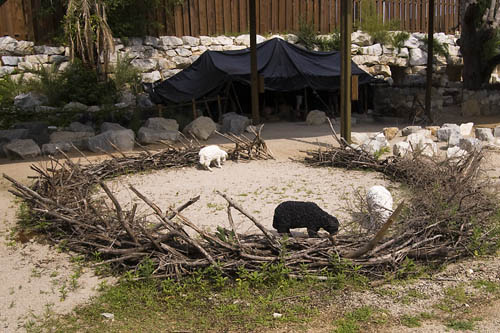"Jesus is the door!"...So...Do We Go In or Out?
I don't always have the opportunity to explore some of he nuances of a passage the way I would like to on Sunday mornings. Additionally, sometimes, I'll get input that makes me start thinking beyond my prep and beyond the time I have to present the results of my studies during the week. Both happened this week. I had more material than I could ever hope to share and one of our Elders intrigued me with a slightly different interpretation of the text, enough so that I thought it might be interesting to develop it in writing as an augment to the sermon.
We covered John 10:1-21, "I Am the Door." Jesus is addressing the Pharisees and uses a lot of vivid imagery to make His point. He speaks of a sheepfold, shepherds (good and bad), thieves, robbers and, in general, uses a lot of flock-related terminology.
 |
| Sheepfold |
In Jesus' parable in John 10:1-6, the sheepfold represents sanctuary, a safe place for the flock.
In the following passage, in John 10:7 Jesus says, "I am the door of the sheep." The imagery in vs 7-18 is not necessarily related to the images presented in vs 1-6, but is vivid nonetheless and significant in its symbolism, as well.
The immediate image in v 7 is that Jesus is the way for the sheep to enter into the sanctuary for safety and the way out, led by Him, for food and water (nourishment). He is simply, elegantly, "the way".
Two verses later, Jesus says that everyone who enters the sheepfold through Him will be saved and "go in and out and find pasture." With this, things start to get interesting. Now, there are a number of ways we can interpret this.
On a very simple basis, we've already seen that Jesus is the way. He's the way to safety inside the sheepfold. He's the way to salvation, the way to spiritual growth and health.
But, to a nomadic people like the ancient Jews, people who were comfortable with temporary structures, this image of Jesus being the door and the sheep going in and out can be very rich indeed. They may have seen it a bit differently than we do. To them, Jesus' intent may be to bring the sheep out of the sheepfold, not keep them in.
 |
| Temporary Sheepfold |
The shepherd would lie down in the doorway to sleep. The sheep would have to go through the shepherd to get out and predators would not be able to get in without waking the shepherd who would fend off the attackers.
One of the more compelling interpretations of Jesus being this type of door goes like this:
The shepherd sleeps in the door way. Jesus is the
shepherd. He is the door, the way to salvation. The sheep, His people, are trapped in the sheepfold, hemmed in by the thorns and brambles. The thorns and brambles are their sins, preventing them from getting out of the sheepfold. Jesus is the way to their salvation, their way into the kingdom beyond the limitations of the sheepfold. The kingdom is where the pastures and sweet water are. The sheepfold, in this interpretation represents bondage to sin. The area outside of the sheepfold represents freedom and peace with Jesus, the good shepherd. They must go through Jesus in order to enter the kingdom. Jesus is the way.
In the final analysis, both interpretations work well. In both of them, Jesus is the way. In both, Jesus is the only path to salvation. Scripture is rich, my friends. The closer we look, the richer it gets!
















No comments:
Post a Comment